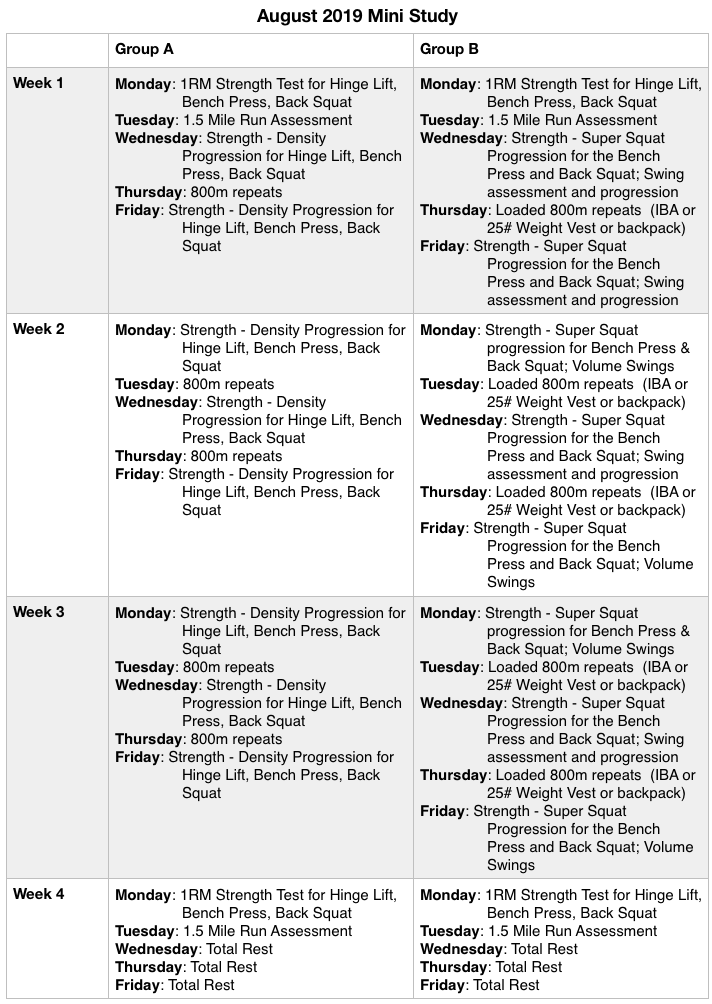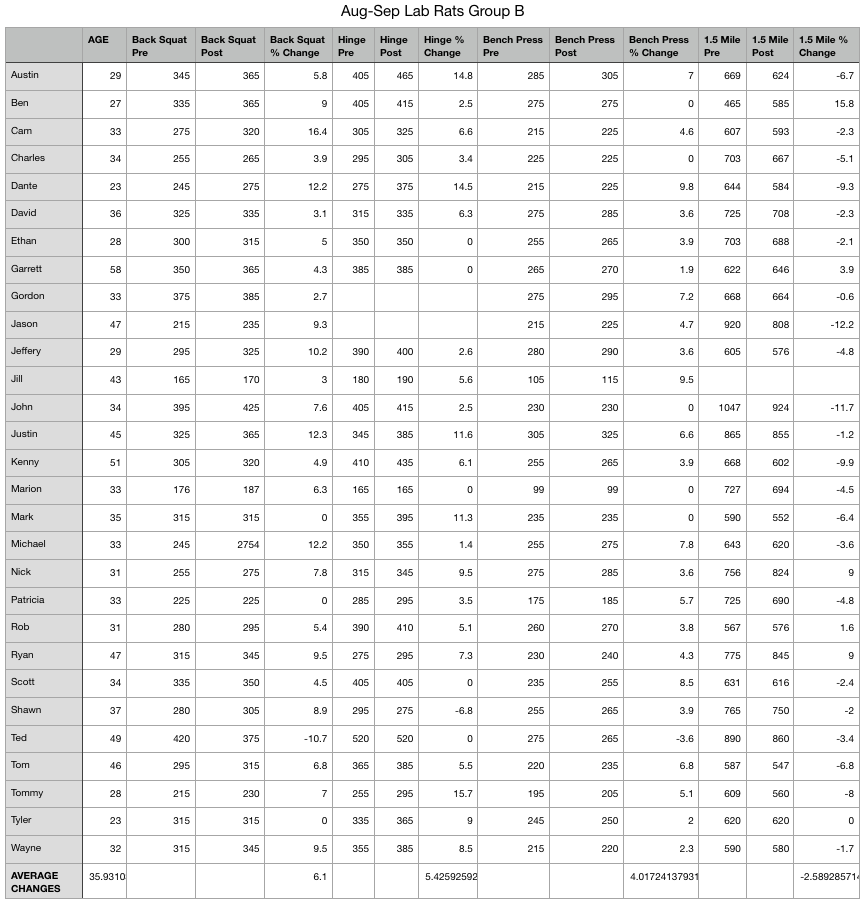
By Rob Shaul, Founder
BLUF
We conducted a 3.5-week Mini-Study using remote lab rats to test:
(1) Density Strength Progression vs. Super Squat Progression for 1RM Increase in the Back Squat and Bench Press
(2) Kettlebell/Dumbbell Swings vs a Hinge Lift Progression to improve Hinge Lift 1RM Strength
(3) Loaded vs. Unloaded Running to Improve 1.5 Mile Run Performance
Results
(1) Density Strength Progression outperformed Super Squat progression for the Back Squat and Bench Press. Density Strength Back Squat average 1RM increase was 8.8% vs a 6.1% increase for Super Squat Progression; Density Strength Bench Press average 1RM Increase was 7.4% vs. a 4.0% increase for Super Squat Progression.
(2) A hinge lift progression outperformed kettlebell/dumbbells swings to increase 1RM Hinge Lift strength. Study subjects which did kettlebell/dumbbell swings only increased their 1RM Hinge Lift by an average of 5.4%, vs an average 8.4% increase in the study subjects who completed hinge lifts.
(3) Loaded vs. Unloaded running to increase 1.5 Mile Run Performance was inconclusive. Study subjects who ran unloaded decreased their 1.5 mile run time by 2.5%, vs. a 2.6% decrease by study subjects who ran loaded.
Background
MTI’s strength and conditioning research is focused on delivering actionable results to improve mission-direct program design.
In past studies, we’ve seen solid strength gains from both MTI’s Density and Super Squat strength progressions, but have never compared them side by side. This study accomplished this.
Kettlebell advocates have indicated gains in Dead Lift / Hinge Lift strength achieved by doing only swings, and anecdotally, we’ve seen similar results using a the similar kettlebell snatch movement. This study tested this theory. With the introduction of the 5RM Trap Bar deadlift in the new Army ACFT and UASF TIer 2 PFTs, offering swings as an alternative to deadlifts for athletes without ready access to a trap bar and plates could be useful for unit fitness leaders.
Loaded vs. Unloaded running to improve 1.5 mile running performance was something we’ve wanted to test for some time. In the past we’ve explored and experimented with different ruck loads to improve rucking performance, but have never done similar for unloaded running performance.
From a Lab Rat / Study Subject perspective, in the past, MTI has conducted most of our Mini Studies using a cadre of local athletes, or working directly with an individual tactical unit. This is the first time we’ve solicited study subjects from the larger MTI community, so in a sense, this study also tested the availability and reliability of remote lab rats for future Mini-Studies. A larger lab rat pool will allow MTI to conduct more frequent Mini-Studies, as well as potentially running multiple Mini-Studies concurrently.
Mini-Study Design/Deployment
A 3.5-week cycle was designed to test the study questions above, and MTI advertised for Lab Rats via our weekly newsletter, Beta, which has 30,000+ weekly subscribers.
Lab Rat volunteers were randomly divided into two groups, A and B, and given access to the individual group programming. Both Groups began their cycles with a Monday 1RM Strength Assessment and a Tuesday 1.5 mile run assessment, which were repeated 3 weeks later.
The Study was completed in the August – September 2019 time frame, and study subject self-reported their pre and post cycle assessment results.
Below, the daily schedule:
- Monday: Strength – Hinge Lift or Swings, Bench Press, Back Squat
- Tuesday: 1.5 Mile Assessment or 800m repeats (loaded for Group B)
- Wednesday: Strength – Hinge Lift or Swings, Bench Press, Back Squat
- Thursday: 1.5 Mile Assessment or 800m repeats (loaded for Group B)
- Friday: Strength – Hinge Lift or Swings, Bench Press, Back Squat
Below is the Cycle outline by Group:

Results/Discussion
A total of 107 individuals volunteered as study subjects for this mini-study, and 59 completed the entire training cycle – a 45% attrition rate.
Nine of the 59 subjects who completed the study were women, and the average study subject age was 35.
Below are the results by Study Group:


No study design is perfect and this study had potential flaws which would affect the findings. Primarily, the effect of the loaded running by Group B on overall fatigue, and its potential influence on strength gain increases. This could be especially evident in the Back Squat, when looking at the Density Strength (Group A) vs. Super Squat (Group B) 1RM gains.
However, that Group A’s density progression also outperformed Group B’s super squat progression on the Bench Press 1RM gives us confidence that density progression would have outperformed for back squat strength improvement, regardless.
Swings vs. Hinge Lifts … Group B (Swings only) saw an average improvement (5.4%) on 1RM Hinge Lift over the course of the cycle, which may indicate the potential of swings to improve 1RM Hinge strength, however, the improvement was noticeably less (5.4% vs. 8.5%) than the Hinge Lift progression. The simple takeaway is if athletes want to improve hinge lift strength, it’s best to do hinge lifts.
Both subject groups saw a similar average decrease in 1.5 mile run times – both around 2.5%. The take away here is the added impact on joints and the body from loaded running does not result in significantly improved unloaded run performance and isn’t needed.
Next Steps?
We were encouraged by the remote lab rat participation for this difficult, intense, mini-study, and are not surprised by the 45% attrition rate. While we haven’t experienced that level of attrition with our local athletes, it’s not unusual to see this or a higher rate for typical academic exercise science research conducted at universities using college students.
From a raw training perspective, this was a very intense training cycle – by design. While we wanted to address the study questions, we were also curious to see the viability of remote lab rats for future mini studies. Would remote athletes who are part of the MTI community suffer through the intense gym-based strength work and loaded 800m repeats? Fifty-nine did!
We were encouraged by what we saw here – the higher training age of the lab rats who completed the cycle – indicating their advanced training experience, and the overall professionalism of the MTI community terms of communication back and forth with MTI.
Several of the study subjects reported “enjoying” the cycle, and seeing improvement. Many have asked for more!
Again, we see potential to significantly accelerate our research with a greatly expanded “lab rat” pool, to include running multiple studies concurrently. In the past, our restricted number of local lab rats has hampered our research ambitions. Remote lab rats get access to great programming, and the opportunity to train with a purpose, while MTI gets the ability to gather data which will improve its programming for the MTI community.
In terms of specific research, we see potential here to continue to test MTI Strength Progressions against one another in an attempt to identify the most effective of our eight strength progressions in a multi-modal training cycle.
Questions,Feedback,Comments? Email rob@mtntactical.com
You Might Also Like Geek Cycle: Leg Blasters Match Front Squat in Building Lower Body Strength
STAY UPDATED
Sign-up for our BETA newsletter. Training tips, research updates, videos and articles - and we’ll never sell your info.
